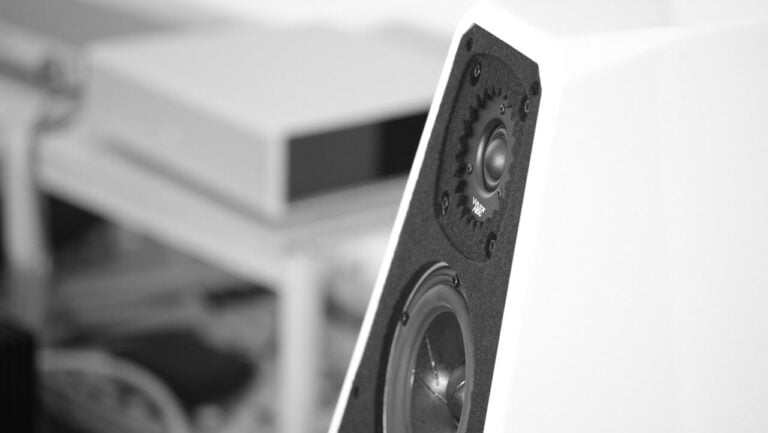The predecessors of the Wilson SabrinaX, which we tested a good five years ago, were owned by a colleague, but they met my listening taste so well during the hearing check that I kept toying with the idea of buying them as work loudspeakers, which would save a lot of money. Especially since the weight class was right, as a tester who notoriously moves equipment, one is happy about every pound that shines through absence. The Generation X Sabrina (24,600 euros) has around eight kilograms more per channel, but still has nothing to do with the heavyweight class – and technically it has grown quite well.
Class instead of mass – if I understand Wilson Audio correctly, the smallest floorstanding speaker in the house is not seen as a qualitatively scaled-down “entry-level model” anyway. But as an uncompromising speaker for specific purposes. These are: small to medium-sized rooms or larger rooms in which, for acoustic or optical reasons, you don’t want to accommodate sound-sounding properties. Incidentally, the recently tested AudiaZ Cadenza pursued very similar goals.
Best Bonds
It is fitting that the three-way speaker , which is just 102 centimeters high with spikes, has recently come up with the same 20-centimeter bass driver that is responsible for the bass in the Sasha DAW, which costs around 45,000 euros – but there in duplicate. The bass reflex system with a tuning frequency of around 31 HertzIn the Wilson SabrinaX, it now blows through an aluminum tube, which can also be found in the Yvette (34,000 euros) and causes even less flow noise. Finally, at the other end of the transmission range, the “Convergent Synergy Tweeter” – namely in the Mk 5 version – ensures detail and airiness, which is used, among other things, in the WAMM Master Chronosonic (here we are also in the real estate business in terms of price). Incidentally, I think it’s kind of cool that Wilson remains so true to itself in terms of drivers and doesn’t use solutions that are currently popular in the high-end area, such as AMTs or ribbons .
Wilson Audio has been working with Scan-Speak for decades and, together with the Danes, develops almost exclusively tailor-made solutions, some of which are then further modified in-house – for example, the tweeter has a rear chamber that is tailor-made.
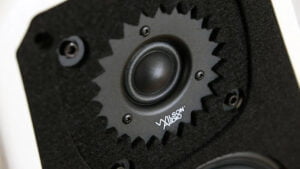
A bit of rusticity…
And why the weird felt on the baffle and the teasing star around the tweeter? This is not new with the Sabrina – and other models from the company – but it is definitely rustic and unique and obviously tried and tested: it simply sounds better with the “Diffraction Pad”, says Wilson Audio. The star around the tweeter is intended to counteract sound components straying on the baffle, not least the localization sharpness benefits from this.
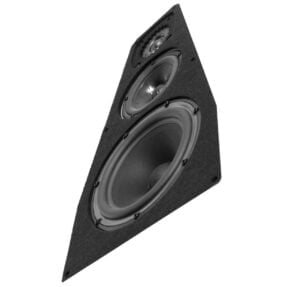
full body x
The X-Material that makes up the Wilson Audio SabrinaX’s case isn’t new either. On the other hand, the fact that the entire housing – and not just the baffle and base as in the predecessors – is made from synthetic resin enriched with minerals according to Wilson’s family recipe is a plus. Less vibrations, less “crate sound”, more real sound – that is, to put it loosely, the way that the Americans have in mind with the generous pouring of resin. And I actually think I can hear this, we’ll come back to it shortly in the sound section.
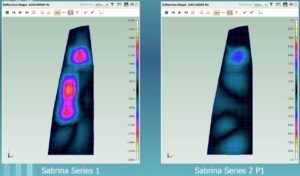
The final milling of the baffle frame surrounding the felt did not work quite so well on one of my two test models. In any case, one of the small, upper corner bevels does not necessarily run straight as a rule. Nothing that’s particularly noticeable, but still a small negligence in workmanship on the otherwise elegantly painted, extremely cleanly manufactured (e.g. edge gradients) and certainly quite complex case in terms of production.
Turn & screw
The bottom line is that what the currently 59 employees of the factory based in Provo – a town with just over a hundred thousand inhabitants roughly 70 km south of Salt Lake City – bring to the listener is also the finest fare in terms of processing. I can’t, for example, not remember holding higher-quality spikes in their hands before. The four-part construction, intended as a mechanical or acoustic “diode”, is also a new development . The SabrinaX has ½-inch threads, the new standard at Wilson Audio. Older models can also be upgraded with the new spike solution, a ⅜ inch version is available separately.
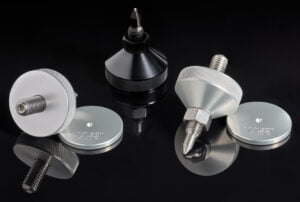
Important, since it is relevant to the sound, as I found out: After installing the spikes and final, wobble-free positioning, do not just tighten the nuts by hand, but with minimal effort! – with the open-end wrench from the enclosed spike and tool box. Among other things, it also contains a key and bit for tightening the driver screws – very nice. Here, too, the following applies: Please be careful and never rock-solid! For torque wrench owners: Wilson factory bolts the drivers to 35 in-lbs, which equates to 3.95 Nm.
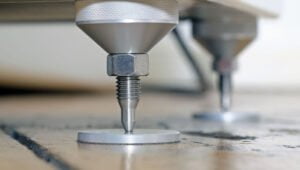
The signal path
A speaker terminal developed in-house on a solid metal plate is not something you see on the rear of speakers every day. It should contribute to the optimization of the even shorter signal path of the Wilson SabrinaX. The crossoveris located at the bottom of the loudspeaker then immediately behind the terminal. This is not implemented using a printed circuit board, but is freely point-to-point soldered – for this price range, however, this is a matter of course. Personally, I think it’s good that the other contacts of the signal path are also soldered and that ugly cable lugs aren’t plugged onto the contact lugs of the drivers. Unfortunately, this is not a standard even in high price ranges. Plug contacts can only be found in the SabrinaX directly behind the terminal and at some resistors.

Of all things with resistance? Yes, behind the detachable base plate of the Wilson Audio SabrinaX are interchangeable resistors that have two functions: On the one hand, sound tuning can be carried out to a certain extent with different resistor values, for example in problematic room acoustic conditions. A practical solution that I know from Sehring loudspeakers. On the other hand, these resistors act as a kind of fuse to protect the expensive drivers: The resistors react more sensitively to voltage peaks or longer-term overloading/heating than the drivers and interrupt the circuit early.
For all that, these resistors are also “the best sounding resistors we’ve listened to, and we’ve listened to a lot of resistors,” as Daryl Wilson writes to me. The love goes even further with the capacitors. So much so that Wilson took over a capacitor manufacturer last year , relocated production to Provo and from then on manufactured custom-made capacitors (“AudioCapX”) on their own machines, which should also ensure little tolerance in terms of capacitance in the SabrinaX.
Wilson SabrinaX: Sound Test & Comparisons
I had already commented positively at the beginning about the weight of the Wilson Audio SabrinaX, which is comparatively easy to handle for a high-end floor-standing loudspeaker. To then find out in the listening room that the SabrinaX don’t let any big pushing and shoving break out: The two guests felt just as comfortable in the marked standard positions and aligned almost “on the axis” (with tweeters aimed at the ears) as I did also know from the vast majority of other loudspeakers. That the sound of the Wilson loudspeakers reacts to even the smallest changes in position, as I have read here and there in English-language articles on the Internet, I cannot confirm – at least in relation to my listening room.
Clear announcement
Let’s try to grab the Wilsons at the low end first – the bass end. Because there are clear announcements to be made here. The first: With spikes just a meter high and armed with a single 20-centimeter woofer, speakers like the SabrinaX aren’t able to work miracles in terms of low bass pressure. The deep black electronic impulses on the first beat for a short time every two bars on “Am I” by Kode9 & The Spaceape (Album: Black Sun) are delivered less powerfully than I do, for example, from my Sehring 903 know. Yes, even in the under 10 kilo euro class you will find many floorstanding loudspeakers that make more inferno at the very, very bottom: I think my listening room walls still vibrate after visiting the Nubert nuVero 170 … But that wants or can too not everyone. Similar to the Audiaz Cadenza, I therefore consider the bass tuning of the Wilson SabrinaX to be more of a concept than an inadequacy: it is also suitable for small and medium-sized rooms.
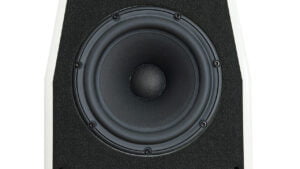
The second announcement: The quality of what the Wilson SabrinaX gives the best underneath is the burner. Absolutely quick to start, extremely clean in the swing-out behavior and tonally (also in itself) extremely balanced. So it’s hardly surprising that the first thing that catches my eye on the track “Our happiest days slowly began to turn into dust” is the electric bass that wanders lightly over different registers, although the real eye-catcher is the post-rockers Red Sparowesbut the ubiquitous pedal steel guitar is. This purity of the tone, the effortless, undelayed tracking of gradations, yes: the transparency of the bass range make the Wilson my personal passive speaker reference at this point. Especially since – and this is perhaps the best thing about it – nothing seems superimposed. In my opinion, for example, “dust-dry-precise” isn’t really the right word, because that would be a certain “taste”. On the bass side, the Wilson Audio SabrinaX put themselves wholeheartedly at the service of the music, without even being extravagant.
Very sympathic. But not unconditionally: The SabrinaX scale more with the amps that fire them than I normally hear: The above listening description basically also applies in combination with my Norma Revo PA 150, but even more so with my Bryston 7B³ . The Wilson show me the differences between the amplifiers, especially the greater control, the more energetic stability of the Bryston blocks, which deliver twice 600 watts. On the one hand, this speaks for the sound level of the loudspeakers, on the other hand it is certainly due to the fact that their predecessors were electrically demanding, especially in the bass range. Performance and load stability are Sabrina’s favorites here, with or without the X.
On the mezzanine

On to the next floor. Via a perfectly designed stairwell: because the connection between the low and medium frequency levels is superbly homogeneous, without even a single, small step provoking stumbling. I think I rarely write about this aspect otherwise. Or at least only if there’s something to criticize during the transition. With the Wilson SabrinaX, however, the bass, fundamental tone and lower mids are effectiveso conclusive, so consistent that I keep noticing it positively over the weeks. Admittedly, I find it rather difficult to describe this subliminal trait with a “hard” musical example. It still feels strikingly “right” when listening – for example when guitar and bass are in close tonal contact or toms and bass drum are wildly vying for attention.
Roller coaster ride to happiness
Bright, glassy, thin. But also soft, reserved, comfortable. All of this applies to the mid-high range. I’m sorry, what? Yes, you read that right, but fortunately that only applies in phases and only over the first 500 operating hours, the SabrinaX arrived brand new. Incidentally, my Spendor D9 had similar strong rashes, although “only” for the first 250 hours or so. My Sehring 903, on the other hand, certainly took as long as the Wilson SabrinaX, but the roller coaster ride was less winding.
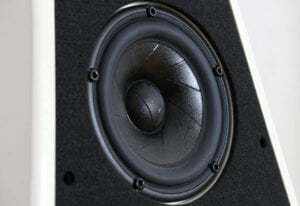
Perhaps this explains one or the other sound description from English-language media, which does not really match my impressions of the Wilson SabrinaX: because at the end of the roller coaster tour, the happy listener can expect an “honest” in the best sense of the word, extremely seamlessly coherent Unity representing mid-high range, which shines even with difficult recordings with a competence that I personally value extremely: Namely, to sound uncompromisingly precise and uncompromisingly stress-free at the same time.
Not cozy, but virtuosic
For example, the opener “Obeliskmonolith” (album: Horizons / Rapture), by the English combo The Physics House Band , which can be classified somewhere between math rock, jazz and post -rock, is admittedly not a typical audiophile gem, but is still better in terms of recording than one would expect from many high- to hear end-chains. The virtuoso swarm of snare and tom rolls, hissing hi-hats and cymbals spreading across the entire stereo panorama is not a particularly cozy reception per se, which is also flanked by uncomfortable organ sounds.
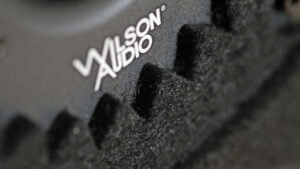
Nevertheless, as a listener you are immediately fascinated, curious and right in the middle of it all. In any case, if a) the ability to differentiate/transparency are at the highest level. Via a whitewashed, soft-focus rig, this song’s intro comes across as entertaining as looking into a lens-clouded kaleidoscope. And b) by no means is there even a touch of “analytically sharpened” chain at the start, which would inevitably subject the eardrum to a sandpaper treatment with this title.
Not the smallest veil on the lens, not even a scrap of sandpaper anywhere: the Wilson Audio SabrinaX draw you into the action as a matter of course right from the start, it sounds exciting, complex and catchy at the same time. The silky, finely atomized, tonally, in case of doubt, even more minimally restrained than cheekily tuned treble of the Wilson is worth an extra applause. Last but not least, when I read Ralph Werner’s report from 2016 , our current SabrinaX should actually achieve an even higher level of quality than its predecessor.
Why actually Sabrina – and not Reiner?
But be that as it may, the degree of purity not only of the highs but also of the mids is enormous either way.
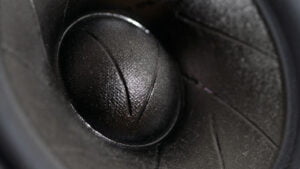
When it comes to freedom from distortion and true-to- sound color fidelity, my very “gryssel-free”-sounding Sehring 903 set a benchmark across all price ranges – the Wilson SabrinaX are fully up there and noticeably go one better in terms of resolution and fine dynamics. In general , I have hardly ever heard a loudspeaker (the AudioSolutions Virtuoso M come to mind) that accurately reproduces even the finest tones in such a way – sorry for the overused word, but it fits here like a glove : the Wilson shine with both a jagged attack as well as with clean, sensitive sustain. Incidentally, an overemphasis on the attack is often the cause of the notorious “(over)analytical” sound.
It goes without saying that the whole thing is also good for voices: Recoil’s “Want” (Album: Liquid) has “only” rap, but it has a great groove to offer – and above all Nicole Blackman’s voice: quietly lascivious, menacingly whispering, soberly cool, Energetic, accompanied by effects or clean, close to the microphone and further away again: With these interplay and nuances, the Wilson SabrinaX succeeds outstandingly in creating tension, and thus distance and intimacy at the same time.
Similar to the recently tested Audiaz Cadenza, the ace up the sleeve when it comes to vocals isn’t a particularly resonant, romantic or smooth voice reproduction, as is sometimes appreciated by lovers of classic British monitors. But the unpretentiousness, the unvarnished conveyance of the real material in its complexity and its multifacetedness – admittedly devoid of any artificial sharpening or harshness. Coils , for example, are also extremely cool(Coincidence, has nothing to do with Recoil) “Where are you” (Album: Musick to Play in the Dark Vol. 2), in which the sampled pops of bursting bubble wrap circle around the voice horizontally – to outside the actual loudspeaker level: The The differently loud pops of the film sound so absurdly realistic that you almost have to laugh. The accompanying percussive scraping noises effortlessly turn out to be sampled, alienated nose-blows. And the roughness of John Balance’s voice, miked from close by, is presented in such a complex and haunting way that, despite all the trappings, you stick to his lips undistractedly. Anyone who likes such realism without any unpleasant harshness, but also without any decorative frills, will love the Wilson SabrinaX.
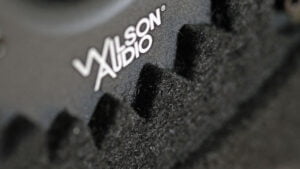
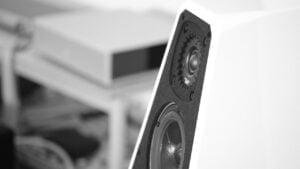
Speaking of mid-high and Audiaz Cadenza: Their ceramic drivers are very similar to the Wilson SabrinaX in terms of undistortedness, purity and immediacy – with high musicality/long-term suitability: Both converters also have in common that they work out voices wonderfully and in a fascinating way ” free”. I remember the Oberbayern a bit more airy and shimmering, but the mids are a little lighter tonally, less padded than the SabrinaX, which is exemplary from head to toe and therefore (comparatively) more sonorous.
Finest stagecraft
The two loudspeaker concepts also differ spatially. The spatiality of the Audiaz Cadenza also works outside of a narrowly defined sweet spot and has an open, spacious charm that is difficult to resist. The Wilson Audio SabrinaX takes a more classic approach and will appeal to fans of coax systems and broadband speakers, coherent two-way systems and high-quality studio monitors: In terms of localization sharpness, depth gradation (which I don’t usually catch in my listening room) and plasticity, the SabrinaX are true masters, just like their predecessors. With an exemplary blackness behind and between the instruments and voices. Last but not least, it is commendable how beautifully absorbing the image is in the direction of the listener. And how stable and coherent transients – such as whipping snares – or voices are formed exactly in the middle of the stereo. When it comes to the stage, the Wilson deliver a performance that has never before been achieved in this quality in my listening room by any loudspeaker that I would recall. Even my former Thiel CS 3.7 with its coax drivers couldn’t keep up by far. The freshly revised
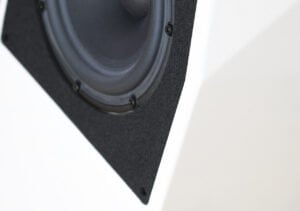
Brazen dynamism
Actually, it should be sufficiently clear in the paragraphs above that the best values are achieved in terms of dynamics: With my combination of Funk MTX and the extremely powerful Bryston 7B³ at the front, what is offered reminds me of what the best active loudspeakers are otherwise able to do in terms of gross dynamics. If you disregard the fact that the SabrinaX, as I said, doesn’t exactly shovel super low, more “bass mass” on the shovel is certainly possible. And finely dynamically on high-end ribbons or AMTs – garnished with a pleasantly silky touch.
One special feature at the end: The Wilson Audio SabrinaX conveys even at high volumes and massive impulses – such as the toms, the bass drum and the electric bass in “Harper Lewis” by Russian Circles (Album: Station) – the feeling of not leaving any energy behind, but firing it in the direction of the listener in an unshakeable, focused and powerful manner. Which, when listening to it loud, gives rise to a feeling of “iron sovereignty” that is difficult to describe, but somehow cool. A feeling that is certainly not least due to the mechanics and therefore to the case, which has been further improved compared to its predecessors. Yes, in the bass and overall in terms of musicality, the SabrinaX has developed further compared to the somewhat “stricter”, “more ascetic” Sabrina, in my opinion.
Wilson Audio SabrinaX – Conclusion
The Wilson Audio SabrinaX do not offer a deliberately presented analytical approach. Nor can it be said that the SabrinaX sounded even the tiniest bean or warmed up. Hm, maybe the treble is tonally a homeopathic jar more subtle than the strictest teaching would be, but that’s more academic than relevant to hearing. The deep bass expansion of the SabrinaX is more relevant to hearing: If you still want to have an alarm far down in the south, you will be better served by many speakers in the price range under 10,000 euros. But if you own smaller and medium-sized rooms (from 20 square meters it can already work) or room acoustically critical, larger rooms up to roughly 40 square meters or simply don’t want to bombard your neighbors,
Either way, the Wilson Audio SabrinaX are among the “most correct”, most balanced, yes: most plausible loudspeakers that I know of. Last but not least, special praise goes to the purity/low distortion and “background blackness”. Listeners who love to bathe in details will appreciate them just as much as those who like it above all organically and musically or those who want to be particularly gripped by dynamics. Or stand on being sucked spatially into the action. Such excellence across the board is not a matter of course, even in this high-end price range. Especially since many loudspeakers are consciously trained for a certain tendency.
Speaking of taste: In terms of my testing activities and listening preferences, the SabrinaX hit the mark in such a way that I really couldn’t help but buy them and let them enrich my work from now on. If you have also become curious and would like to try out the SabrinaX, make sure you have adequate amplification – the performance and load stability appreciate the Wilson Audio SabrinaX audibly.
The Wilson Audio SabrinaX are characterized by…
- a sound image that is as transparent, precise as it is musical and suitable for long-term use.
- a consistency and coherence that immediately connects the listener to the music, which is otherwise more familiar from smaller two-way loudspeakers.
- Textbook-like neutrality, at most the treble is a touch reduced on the level side.
- a spring water-like pure sound, not least tone colors and the famous black background benefit from this.
- a fascinating subtlety, tones are traced with exemplary clean, fast attack and accurate, full-bodied sustain.
- an exceptionally fine-pixel, more silky than ostentatiously analytical high tone.
- a midrange that is as organic as it is informative with fascinatingly authentic voice reproduction.
- an exemplary, differentiating, dynamically wonderfully energetic and powerful bass. When it comes to depth and thrust, floor-standing loudspeakers can often do even more.
- a three-dimensionality that passes as a benchmark for many other systems: Last but not least, the clean, stable stereo center and the perceived “blackness” behind and between the instruments and voices, which can be clearly located, are worth mentioning. Only the stage height could perhaps be improved for such a top speaker.
- a very high-quality workmanship (housing, terminal, driver screw connections, spikes) with minimal rusticity in detail (felt on the baffle, inner edge of the baffle is not absolutely straight at a small point).
Facts:
- Model: Wilson Audio SabrinaX
- Concept: passive three-way floorstanding speaker (bass reflex system)
- Price: 24,600 euros, Ivory test version: 25,600 euros
- Dimensions (with spikes) & Weight: 30 x 39 x 102 cm (WxDxH), 50.8 kg/each
- Standard finishes: Carbon, Galaxy Gray, GT Silver, Quartz; Further “Upgrade Colors” are available as an option and at an additional cost
- Efficiency: 87dB/1W/1m
- Nominal Impedance: 4 ohms (minimum at 2.6 ohms at 135 Hertz)
- Guarantee: 5 years upon registration
Review: Wilson Audio SabrinaX – “Small” floor-standing loudspeakers



